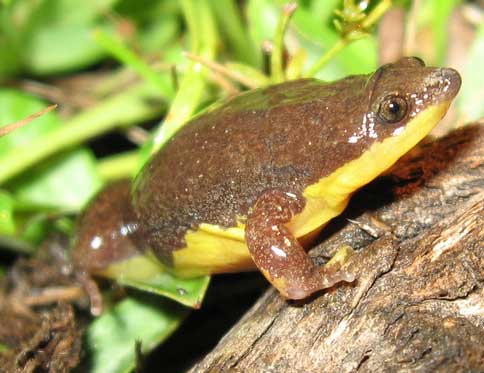
Elachistocleis bicolor (*)
Superregnum: Eukaryota
Cladus: Unikonta
Cladus: Opisthokonta
Cladus: Holozoa
Regnum: Animalia
Subregnum: Eumetazoa
Cladus: Bilateria
Cladus: Nephrozoa
Superphylum: Deuterostomia
Phylum: Chordata
Subphylum: Vertebrata
Infraphylum: Gnathostomata
Megaclassis: Osteichthyes
Cladus: Sarcopterygii
Cladus: Rhipidistia
Cladus: Tetrapodomorpha
Cladus: Eotetrapodiformes
Cladus: Elpistostegalia
Superclassis: Tetrapoda
Classis: Amphibia
Subclassis: Lissamphibia
Ordo: Anura
Familia: Microhylidae
Subfamilia: Gastrophryninae
Genus: Elachistocleis
Species: Elachistocleis bicolor
Name
Elachistocleis bicolor (Guérin-Méneville, 1838)
Type locality: "l'Amerique méridionale [= South America]".
Holotype: MNHNP ?
Synonyms
Oxyrhynchus bicolor Guérin-Méneville, 1838
Oxyrhincus bicolor — Duméril and Bibron, 1841
Engystoma ovale var. bicolor — Boulenger, 1885
Engystoma ovale lineata Miranda-Ribeiro, 1920
Engystoma ovale cesarii Miranda-Ribeiro, 1920
Engystoma cesarii mottae Miranda-Ribeiro, 1920
Engystoma ovale concolor Miranda-Ribeiro, 1920
Elachistocleis ovale bicolor — Parker, 1927
Elachistocleis ovalis bicolor — Müller and Hellmich, 1936
Elachistocleis bicolor — Carvalho, 1954
References
Guérin-Méneville, 1838, Icon. Regne Animal, 3: 17, pl. 27, fig. 2.
Carvalho, 1954, Occas. Pap. Mus. Zool. Univ. Michigan, 555: 1–19.
Frost, D.R. 2021. Amphibian Species of the World: an Online Reference. Version 6.1. Electronic Database accessible at https://amphibiansoftheworld.amnh.org/index.php. American Museum of Natural History, New York, USA. DOI: 10.5531/db.vz.0001 Elachistocleis bicolor . Accessed on 17 June 2008.
2007 IUCN Red List of Threatened Species IUCN: Elachistocleis bicolor (Least Concern) Downloaded on 17 June 2008.
Vernacular names
English: Two-colored Oval Frog
Elachistocleis bicolor (common name: two-colored oval frog, Spanish: rana pinguino or sapito panza amarilla) is a species of frog in the family Microhylidae. It is found in central Argentina and northward through Paraguay and Uruguay to Amazonian Brazil; earlier reports from Bolivia probably refer to Elachistocleis haroi.[2]
Habitat
Elachistocleis bicolor is an abundant species occurring in seasonally flooded grasslands and in dry and moist forests. It can also survive in rural gardens and urban areas.[1]
Description
Elachistocleis bicolor are nocturnal and semi-fossorial in their lifestyle. During periods of aestivation, they can be found inside ant and termite nests.[3] Male Elachistocleis bicolor grow to a snout–vent length of 23–32 mm (0.91–1.26 in) and females to 27–36 mm (1.1–1.4 in). Its name refers to its striking colour pattern with brownish back and yellowish dorsum.[4]
Elachistocleis bicolor feed primarily on ants[1] and termites, with other insects making minor contributions to their diets. In one study in Uruguay, termites were more important during the inactive season whereas ants (particularly Pheidole and Solenopsis) were more important during the active season.[3]
Reproduction
Reproduction takes place during the wet season[4] in pools with standing water.[1] Fecundity is about 620 eggs and positively correlated with female size.[4] Eggs float on top of the water.[1]
References
Esteban Lavilla, Ismael di Tada, Jose Langone (2004). "Elachistocleis bicolor". IUCN Red List of Threatened Species. 2004: e.T57807A11684903. doi:10.2305/IUCN.UK.2004.RLTS.T57807A11684903.en. Retrieved 17 November 2021.
Frost, Darrel R. (2014). "Elachistocleis bicolor (Guérin-Méneville, 1838)". Amphibian Species of the World: an Online Reference. Version 6.0. American Museum of Natural History. Retrieved 20 March 2014.
Berazategui, M.; Camargo, A.; Maneyro, R. L. (2007). "Environmental and seasonal variation in the diet of Elachistocleis bicolor (Guérin-Méneville 1838) (Anura: Microhylidae) from northern Uruguay". Zoological Science. 24 (3): 225–231. doi:10.2108/zsj.24.225. PMID 17551242.
Rodrigues, D. D. J.; Lopes, F. S.; Uetanabaro, M. (2003). "Padrão reprodutivo de Elachistocleis bicolor (Anura, Microhylidae) na Serra da Bodoquena, Mato Grosso do Sul, Brasil" [Reproductive pattern of Elachistocleis bicolor (Anura, Microhylidae) at Serra da Bodoquena, Mato Grosso do Sul, Brazil]. Iheringia. Série Zoologia (in Portuguese and English). 93 (4): 365–371. doi:10.1590/S0073-47212003000400003.
Retrieved from "http://en.wikipedia.org/"
All text is available under the terms of the GNU Free Documentation License

